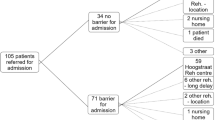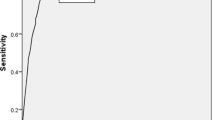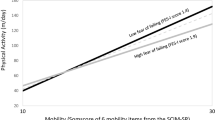Abstract
The aim of the present study was to set targets for each spinal lesion level after determining the relationship between the spinal lesion level and movement abilities in patients with tetraplegia following injury to the cervical cord. A total of 109 patients, 96 men and 13 women were included in the study. We mainly examined locomotion and transfer capabilities according to Zancolli's classification. The results of this study showed that 50% of the patients classified as C6A, 75% of C6B1 and 96% of the patients classified C6B2 accomplished bed transfer. The number of patients who could manage toilet transfer was 53% in the group classified as C6B1 and 85% in group C6B2. These results suggest that achievement of those classified as C6B2 is a clue to the assumption that the patient will achieve toilet transfer capability and can perform ADL independently.
Similar content being viewed by others
Log in or create a free account to read this content
Gain free access to this article, as well as selected content from this journal and more on nature.com
or
References
Bromley I . Tetraplegia and Paraplegia. 3rd Japanese edn. Tokyo: Igaku Shoin, 1978, pp 20–26.
Yabe Y . Reconstructive surgery for the quadriplegic hand. Sogo Rehabil 1974; 2: 536–543.
Zancolli E . Structural and Dynamic Basis of Hand Surgery. 2nd edn. Lippincott: Philadelphia, 1979.
Kanematsu H et al. Potential in activities of daily living of spinal cord lesions. Sogo Rehabil 1976; 4: 793–799.
Fukushima T . Training of postural and bed activities for quadriplegic patients at home. Rigaku ryoho to Sagyo Ryoho 1982; 6: 41–50.
Nakayama A . Transfer ability of quadriplegic patients. Rigaku ryoho to Sagyo Ryoho 1982; 16: 303–309.
Shino T . Bed mobility and transfer in quadriplegia. Rigaku ryoho janaru 1990; 24: 453–457.
Shimoda H, Onoda H . Programming of physical therapy 4: Physical therapy program for spinal cord injury. Rigaku ryoho janaru 1990; 24: 243–248.
Ando N et al. Some considerations and kinesiological analyses of push-up motion in patients with quadriplegia. Sogo Rehabil 1979; 7: 657–663.
Hashimoto T . Physical therapy for quadriplegia. Sogo Rehabil 1974; 2: 47–53.
Hakata S, Doi T . Follow-up study on patients with cervical cord injury. Sogo Rehabil 1979; 7: 671–675.
Joan C R . Traumatic quadriplegia, follow-up study of self-care skill. Arch Phys Med Rehabil 1980; 61: 316–321.
Ando N . ADL tests for quadriplegia. Sogo Rehabil 1982; 10: 1033–1037.
Mizukami M et al. Sitting balance of paraplegic patients. Nat Rehabil Res Bull Jpn 1984; 5: 27–34.
Kikuya O et al. Biomechanical analysis of push-up motion in patients with spinal cord injury. Rigaku ryoho to Sagyo Ryoho 1987; 21: 162–168.
Yarkony G M et al. Rehabilitation outcomes in C5 quadriplegia. Am J Phys Med Rehabil 1988; 73–76.
Yarkony G M et al. Rehabilitation outcomes in C6 quadriplegia. Paraplegia 26: 177–185.
Ford J R, Duckworth B . Physical Management for the Quadriplegic Patient. 2nd Japanese edn. Tokyo: Ishiyaku Publishers, 1990, pp. 615–631.
Mizukami M . Practice of ADL training 1: Sitting-up and transfer exercises in quadriplegics. Rigaku ryoho janaru 1991; 25: 485–491.
Author information
Authors and Affiliations
Rights and permissions
About this article
Cite this article
Mizukami, M., Kawai, N., Iwasaki, Y. et al. Relationship between functional levels and movement in tetraplegic patients. A retrospective study. Spinal Cord 33, 189–194 (1995). https://doi.org/10.1038/sc.1995.43
Issue date:
DOI: https://doi.org/10.1038/sc.1995.43



